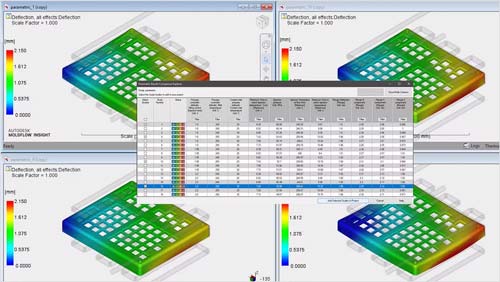Five Reasons to Use Mold Flow Simulation Software for Injection Molding
Leave a Comment
Are you leveraging mold flow simulation software to optimize your molds and injection molding process? You should be. Here’s why: injection molding is a complex process, and is subject to threats such as warping, uneven cooling, material defects, and much more. Historically, these challenges were only discovered through trial and error, leading to costly mold reworks, part design changes, and process modifications; all resulting in frustrating production delays. Wouldn’t it be great if you could foresee and resolve these problems before they occur? You can thanks to plastic mold flow simulation software.
This technology has been hailed as a game-changer for the injection molding industry. This powerful software allows users to virtually replicate the entire molding process, from filling the mold cavity to the final cooled part. This enables designers and engineers to optimize material choice, process settings, cooling efficiency, and other critical production aspects. There are many benefits to leveraging this technology, including:
- Reduced Development Time and Costs – by identifying issues in the design phase, prior to production, you can avoid mold revisions and production delays. The process allows you to optimize your molds for efficient filling, consistent part quality, and minimal material waste before the mold is even made. A good mold is expensive, so you need to get it right the first time!
- Improved Part Quality – the software helps predict and prevent common defects such as warpage, shrinkage, and air traps. By solving these issues on screen, you’ll get parts that have consistent dimensional accuracy and aesthetics with superior mechanical strength.
- Easier Design Optimization – simulation software provides the ability to optimize part design beyond simply preventing defects. It helps achieve better part functionality. By visualizing flow within the mold, you can optimize gate location and size for balanced filling. It also allows you to predict warpage and shrinkage when cooling, so the design or mold dimensions can be adjusted to help assure that the final part meets functional tolerances and dimensions when cooled.
- Enhanced Innovation – if you’ve ever wanted to improve your part design, you already know the factor that slows you down: fear! Will the proposed new material work? Will modifications to part geometry disrupt the process? These questions and more can be answered with simulations. They give you the freedom and flexibility to optimize process factors, without the fear of failing.
- Improved Production Efficiency – by maximizing your mold design and process considerations through simulation, you can benefit from faster cycle times, and higher yields, along with reduced energy consumption, defective parts, and waste. Keep in mind that in addition to geometry and material, the software takes many other factors into account such as pressure and flow rate.
Wait – This Sounds Too Good to be True!
It’s true: mold flow and process simulation has indeed been a game changer. But, as will all technological innovation, it’s not perfect. It’s software. One drawback is that it assumes that everything is perfect such as the mold, the machine, the material, and environmental conditions. In reality, these things are subject to imperfection and variation. For instance, materials can have viscosity issues, which will change the flow properties. A brand new machine will function much better than say a twenty- or thirty-year-old machine. Another key factor is heat, which plays a huge role in part cooling and mold design. While the software may consider certain thermal factors, it doesn’t know all of them. The bottom line here is that there are real-world drawbacks, and it’s up to the manufacturer to be aware of these and to compensate for them accordingly.
If you are not employing this impressive cost-saving technology yet, why wait? If budget is a concern, you can simply work with a plastic injection molding shop, such as PDI, that includes simulation as a value-added service. In doing so, you’ll optimize your part quality and consistency, while reducing mold and material costs and waste. All adding up to reliable components and a healthier bottom line.
Have a question about mold flow simulation or want to see how you can benefit? Contact us today.
Image Source: autodesk.com
